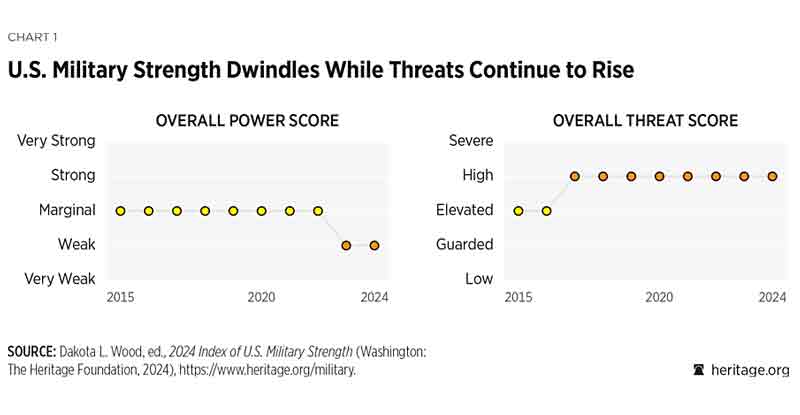By Micaela Burrow | The Daily Caller
The U.S. military is already overstretched in responding to global threats and too weak to deal with the most pressing challenges to U.S. national security, according to a report released by a conservative think tank on Wednesday.
The Heritage Foundation’s 2024 Index of U.S. Military Strength functions as a report card for the progress of the U.S. military relative to the global operating environment and adversaries’ capabilities and rated the military overall as “weak,” editor and retired Marine Corps Lt. Col. Dakota Wood told the Daily Caller News Foundation.
In 2023, wars in Ukraine and Israel, compounded with the U.S. response to conflict exploding throughout the Middle East, put the U.S. military in a spotlight, demonstrating deficiencies in U.S. ammunition and weapons stockpiles and the ability to answer the president’s call to intervene simultaneously in more than one crisis.
“As currently postured, the U.S. military is at significant risk of not being able to defend America’s vital national interests,” the introduction to the index reads.
The U.S. military received a “weak” rating for the second year in a row “relative to the force needed to defend national interests on a global stage against actual challenges in the world as it is rather than as we wish it were,” it added.
Overall, all branches of the armed services, as well as U.S. nuclear and missile defense assets, are too old, too weak and too unready, Wood, Heritage’s senior research fellow for defense programs, told the DCNF at a briefing ahead of the report’s formal release.
Heritage blamed the Pentagon’s decision to keep forces deployed for longer than planned, lack of funds, poor discipline in developing and procuring weapons programs, and constantly shifting priorities and policies for driving the decline in U.S. military strength.
“When we say that the U.S. military is weak, it’s not an indictment of the individuals,” the men and women in service, Wood explained. “If you had to go up against Russia or China or Iran or some other actor in the world, you’re just not going to have a sufficient amount of military power to go out.”
The overall rating isn’t a change from last year, but U.S. nuclear forces received a downgrade from 2023 in the 2024 report.
Heritage rated the Army as “marginal,” the Navy as “weak”” and the Air Force as “very weak.”
Only the Marine Corps came out as strong, thanks to its monumental modernization efforts focused on a worst-case-scenario fight with China, according to Wood, but it remains too small to accomplish the missions the Pentagon tasked it with in the previous year.
The Air Force fared worst of all, receiving a “very weak” rating. Besotted with a pilot shortage, it operates just 75% of the ready fighter aircraft needed to devote to two major conflicts at once, according to the report.
Pilots also aren’t getting enough hours in the cockpit — less than 130 each year on average, which in the Cold War era would have rendered them combat ineffective, Wood told the DCNF.
“There is not a fighter squadron in the Air Force that holds the readiness levels, competence, and confidence levels that are required to square off against a peer competitor,” the report stated.
The relatively young Space Force rated as “marginal,” reflecting a lack of personnel and satellite constellations that have exceeded their life cycles.
U.S. nuclear forces are “ancient,” Wood told the DCNF, while one of the most important modernization programs, replacing Cold War-era Minuteman III intercontinental ballistic missiles, has encountered financial difficulties requiring secretary of defense intervention to save it from termination.
“Nearly all components of the nuclear enterprise are at a tipping point with respect to replacement or modernization,” the report read.
Wood highlighted this as an area of particular concern. All other U.S. military operations depend on a strong nuclear deterrent to prevent catastrophic nuclear escalation from peer threats like China.
The Army is now the smallest on record since before World War II at a time when many warn the U.S. is in a more dangerous place than any time since, Wood said. In 2023 it fielded 452,000 active duty soldiers, and that number will drop to 445,000 — down from 770,000 since the end of the Cold War.
It’s too small to respond to more than one major regional conflict at a time and continues to shrink, while the weapons systems that make up the cornerstone of Army capabilities are rapidly aging out, according to Wood.
M1 Abrams Main Battle Tanks, for example, began development in the 1960’s. As they get older, the cost to maintain and service the equipment only grows, but the Army doesn’t have a plan to replace them until the 2050’s, Wood said.
The index is “not a futures document,” Wood told the DCNF. It looks at the present force and matches it with the ways a more diverse set of threats in a more complicated world could threaten the U.S. security.
Although the U.S. military is preparing to deter and if necessary prosecute a fight with China, unexpected events can trigger a U.S. response at any time, Wood said. Developments in the Middle East, including the Houthi rebel group in Yemen effectively blockading Red Sea shipping, have disrupted U.S. Navy deployments.
The Navy received a rating of “weak.”
On a tactical level, it has performed fairly well in shooting down Houthi missiles and drones launched at commercial shipping and mounting counterattacks on Houthi capabilities on land, Wood said. However, it is striving, and struggling, to maintain a global presence with a fleet half the size of what commanders say they need, leading to stress on the platforms and personnel.
The USS Bataan amphibious ready group (ARG) and 26th Marine Expeditionary Unit deployed to the Middle East in July to patrol the Persian Gulf. It was since reassigned to the Mediterranean Sea to bolster the USS Gerald R. Ford aircraft carrier providing deterrence against other actors cashing in on Israel’s war with Hamas, as the Ford’s deployment had been extended multiple times, Politico reported.
The Boxer ARG was scheduled to replace the Bataan in November, but has been held up in San Diego, California, as it undergoes additional training exercises, according to Politico. The Navy has been circumspect regarding the Boxer’s condition, and officials say the ship could remain on deployment “indefinitely.”
Time is growing short to reevaluate U.S. spending priorities, experts, speaking at a panel after the index’s unveiling, warned.
Military equipment has become exponentially more expensive relative to increases in defense spending, even adjusted for inflation, according to Wood.
Defense budgets have not kept pace with inflation and are inadequate to replace, upgrade and expand the U.S. military, according to the report. The U.S. defense budget increased 3.5% between 2023 and 2024, while inflation increased 8%.
“If we now get super real, this is not just about recognizing the threat,” Elbridge Colby, a former deputy assistant secretary of defense for strategy and force development, said on a Heritage panel Wednesday. “We have to reevaluate like a business that’s about to go bankrupt.”
The Pentagon did not respond to the DCNF’s request for comment.
2024 Index of U.S. Military Strength (Heritage Foundation)








Leave a Comment